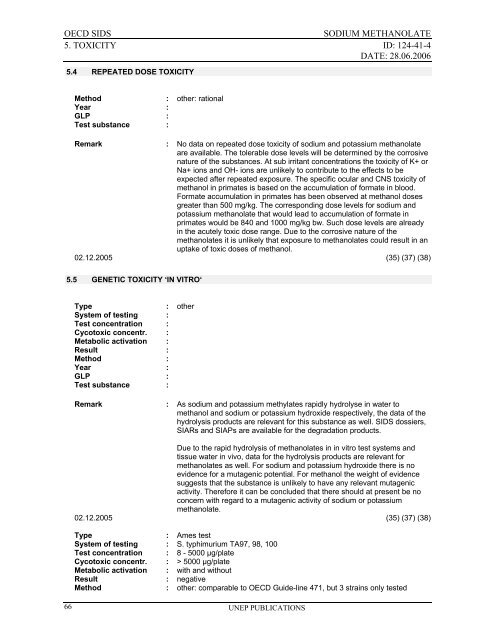Sodium methanolate - ipcs inchem
Sodium methanolate - ipcs inchem
Sodium methanolate - ipcs inchem
Create successful ePaper yourself
Turn your PDF publications into a flip-book with our unique Google optimized e-Paper software.
OECD SIDS<br />
SODIUM METHANOLATE<br />
5. TOXICITY ID: 124-41-4<br />
DATE: 28.06.2006<br />
5.4 REPEATED DOSE TOXICITY<br />
Method : other: rational<br />
Year :<br />
GLP :<br />
Test substance :<br />
Remark : No data on repeated dose toxicity of sodium and potassium <strong>methanolate</strong><br />
are available. The tolerable dose levels will be determined by the corrosive<br />
nature of the substances. At sub irritant concentrations the toxicity of K+ or<br />
Na+ ions and OH- ions are unlikely to contribute to the effects to be<br />
expected after repeated exposure. The specific ocular and CNS toxicity of<br />
methanol in primates is based on the accumulation of formate in blood.<br />
Formate accumulation in primates has been observed at methanol doses<br />
greater than 500 mg/kg. The corresponding dose levels for sodium and<br />
potassium <strong>methanolate</strong> that would lead to accumulation of formate in<br />
primates would be 840 and 1000 mg/kg bw. Such dose levels are already<br />
in the acutely toxic dose range. Due to the corrosive nature of the<br />
<strong>methanolate</strong>s it is unlikely that exposure to <strong>methanolate</strong>s could result in an<br />
uptake of toxic doses of methanol.<br />
02.12.2005 (35) (37) (38)<br />
5.5 GENETIC TOXICITY ‘IN VITRO‘<br />
Type : other<br />
System of testing :<br />
Test concentration :<br />
Cycotoxic concentr. :<br />
Metabolic activation :<br />
Result :<br />
Method :<br />
Year :<br />
GLP :<br />
Test substance :<br />
Remark : As sodium and potassium methylates rapidly hydrolyse in water to<br />
methanol and sodium or potassium hydroxide respectively, the data of the<br />
hydrolysis products are relevant for this substance as well. SIDS dossiers,<br />
SIARs and SIAPs are available for the degradation products.<br />
Due to the rapid hydrolysis of <strong>methanolate</strong>s in in vitro test systems and<br />
tissue water in vivo, data for the hydrolysis products are relevant for<br />
<strong>methanolate</strong>s as well. For sodium and potassium hydroxide there is no<br />
evidence for a mutagenic potential. For methanol the weight of evidence<br />
suggests that the substance is unlikely to have any relevant mutagenic<br />
activity. Therefore it can be concluded that there should at present be no<br />
concern with regard to a mutagenic activity of sodium or potassium<br />
<strong>methanolate</strong>.<br />
02.12.2005 (35) (37) (38)<br />
Type : Ames test<br />
System of testing : S. typhimurium TA97, 98, 100<br />
Test concentration : 8 - 5000 µg/plate<br />
Cycotoxic concentr. : > 5000 µg/plate<br />
Metabolic activation : with and without<br />
Result : negative<br />
Method : other: comparable to OECD Guide-line 471, but 3 strains only tested<br />
66<br />
UNEP PUBLICATIONS
















